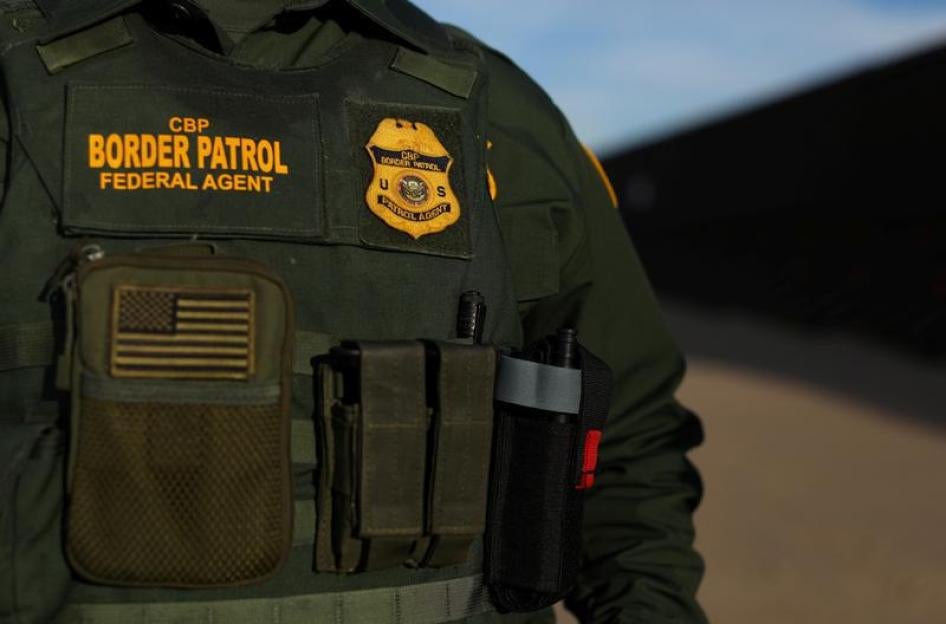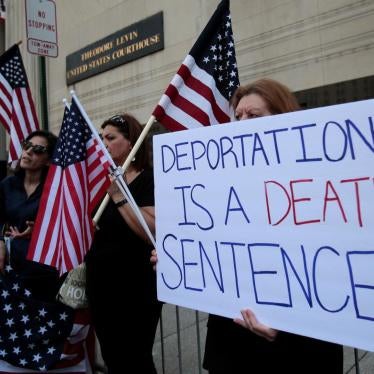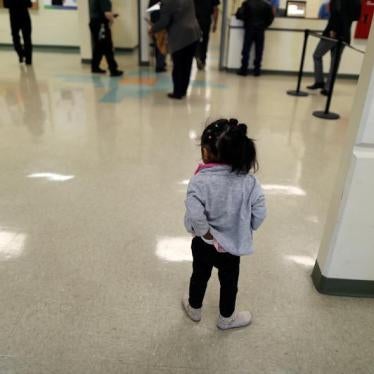(Washington, DC) – US Customs and Border Protection (CBP) agents have turned away unaccompanied children seeking asylum at the border, exposing them to the danger of return to the countries they fled, Human Rights Watch said today.
US immigration officials at the Tijuana-San Diego border posts and elsewhere have been “metering” asylum applicants – allowing a limited number in each day – since the summer, intensifying a practice that emerged under the Obama administration. Getting on the waitlist is an uncertain process and usually requires photo identification, which many unaccompanied children do not have.
Separately, a Department of Homeland Security policy announced Thursday aims to return asylum seekers to Mexico while their claims are processed in the US, raising serious concerns about whether asylum-seeking adults and families will be able to access fair and timely procedures and wait safely in Mexico. Department of Homeland Security Secretary Kirstjen Nielsen told Congress on Thursday that unaccompanied children will not be subject to this new policy.
Waiting in Mexico presents its own risks. Children face a real risk of deportation from Mexico – including to situations of persecution and violence – by Mexican immigration officials. There are also potential security risks for migrants in northern Mexico. Two Honduran children were murdered in Tijuana on Saturday while in the process of moving from one migrant shelter to another, according to news reports.
“Children who seek asylum at the US-Mexico border face an impossible situation, with the administration telling them not to cross outside of official ports of entry but then turning them back at official border crossings,” said Michael Garcia Bochenek, senior children’s rights counsel at Human Rights Watch.
In a recent case, agents turned away eight boys – seven from Honduras and one from Mexico – who had walked from their shelter to the Otay Mesa border crossing, another of the crossings between Tijuana and San Diego, to seek asylum on December 4, 2018. Each had been in Tijuana for about two months, including several weeks at an increasingly fetid camp in the Benito Juárez stadium, while they tried to determine how they could seek asylum in the US, three of the boys told Human Rights Watch.
The boys were assisted by a team of lawyers volunteering with Al Otro Lado, a nonprofit in Tijuana that helps asylum seekers. When they arrived at the border crossing, agents made everybody in the group step back and line up against the wall, the boys and the lawyers said. The boys thought they were waiting to see a more senior US immigration officer, they told Human Rights Watch. Instead, after about an hour, Mexican immigration officials arrived and threatened to deport everybody in the group, the boys and their lawyers said.
Some of the boys were standing on the US side of the border when they told CBP agents they were requesting asylum, said Anna Joseph, one of the attorneys accompanying the group. But the agents ordered them to step back into Mexican territory. Then a row of border agents – at least five, in the videos and photos Human Rights Watch viewed – stood along the line marking the physical border.
After protracted negotiation, CBP allowed the Mexican boy to walk in and seek asylum. Mexican officials let the seven Honduran boys go back to their shelter, and escorted those of the lawyers without Mexican passports or residence permits to the line and told them to walk into the US.
Human Rights Watch and other groups have heard accounts of turnbacks at the border for months, at least since the administration’s forcible family separation policy went into effect. In July, Human Rights Watch researchers observed border agents at crossing points in the Rio Grande Valley stopping all pedestrians at the midpoint of international bridges to check identification, and turning away those who did not have border crossing cards, visas, or US passports. Some families with children and unaccompanied children interviewed in June, July, September, and October said they were turned away at official border crossings when they requested asylum. Legal monitoring teams with the nongovernmental organization Human Rights First found turnbacks and “orchestrated bottlenecks” at many US border crossings in November and December.
Official statements and CBP agents sometimes suggest that “metering” is necessary because official border posts have limited capacity to take in asylum seekers.
It is not clear on what basis US officials say they lack capacity to process asylum seekers at the border. The numbers of families and unaccompanied children processed at regular border crossings have gone down significantly since May, when the border patrol started routinely placing uniformed agents just inside the line marking the international border. And CBP’s data show that far fewer asylum seekers are processed each day than the agency itself says it can handle.
Families and unaccompanied children told Human Rights Watch in interviews between June and December that border agents claimed that the post was “full” when they sought asylum. CBP Acting Commissioner Kevin McAleenan told reporters in October: “We’re not turning people away. We’re asking them to wait.” Advocates report that US border agents have sometimes permitted children and other vulnerable people to apply for asylum at official border entry points, known as “ports of entry,” without requiring them to be on the waitlist – but only if they are accompanied by a lawyer or other advocate.
The boys who sought asylum in the US at the Otay Mesa port of entry on December 4 were told to go to another checkpoint, the “Pedestrian West” crossing in the center of Tijuana, Joseph said. But Al Otro Lado’s experience at that border crossing is that asylum seekers who are not on the waitlist – even unaccompanied children, who as a practical matter cannot get on the list – are turned away. In late November, Mexican immigration officials detained two undocumented and unaccompanied Central American children who tried to request asylum at the San Ysidro Pedestrian West crossing in preparation for their deportation, said Nicole Ramos, a lawyer with Al Otro Lado.
Under the so-called Migration Protection Protocols, in addition to the risk of return to the harm they fled, unaccompanied children and families with children face the prospect of open-ended waits in precarious conditions. Shelters in Tijuana and elsewhere along the border are at capacity. Families and unaccompanied children who were in the Benito Juárez stadium before it was closed at the end of November reported shortages of food and unsanitary conditions, particularly after heavy rainfall flooded the grounds. And unaccompanied children face other risks while they wait in Mexico, including violent crime.
Turnbacks at official border crossings have unsurprisingly coincided with an increase in irregular entry – for instance, by wading the river or scaling border walls. The US Department of Homeland Security’s Office of Inspector General said in September that it “saw evidence that limiting the volume of asylum-seekers entering at ports of entry leads some aliens who would otherwise seek legal entry into the United States to cross the border illegally.”
International law prohibits the government from returning people to countries where they face the risk of torture or threats to their lives or freedom. This international obligation applies to indirect acts that have the effect of returning people to harm – for example, when weeks or months of delay and uncertainty lead children to believe that they have no access to the asylum process and no practical option but to return to countries where they face serious risk of persecution or threats to their lives or safety.
To avoid the risk that Mexican immigration authorities will return children to harm in their home countries after US immigration agents turn them away from border posts, CBP agents and other US officials should allow unaccompanied children to apply for asylum, transferring these children to the custody of the US Department of Health and Human Services.
“Border turnbacks and the new policy needlessly expose children to harm,” Bochenek said. “They shouldn’t face weeks in squalid camps, the anxiety of not knowing if or when they’ll have a fair hearing, and the possibility of return to a risk of persecution or other serious abuse.”









